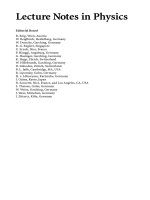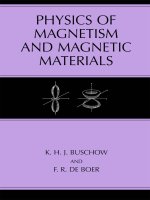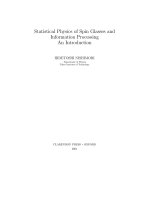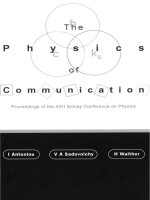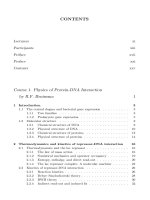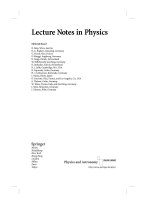- Trang chủ >>
- Khoa Học Tự Nhiên >>
- Vật lý
egbers c., pfister g. (eds.) physics of rotating fluids
Bạn đang xem bản rút gọn của tài liệu. Xem và tải ngay bản đầy đủ của tài liệu tại đây (12.85 MB, 445 trang )
Lecture Notes in Physics
Editorial Board
R. Beig, Wien, Austria
J. Ehlers, Potsdam, Germany
U. Frisch, Nice, France
K. Hepp, Z
¨
urich, Switzerland
W. Hillebrandt, Garching, Germany
D. Imboden, Z
¨
urich, Switzerland
R. L. Jaffe, Cambridge, MA, USA
R. Kippenhahn, G
¨
ottingen, Germany
R. Lipowsky, Golm, Germany
H. v. L
¨
ohneysen, Karlsruhe, Germany
I. Ojima, Kyoto, Japan
H. A. Weidenm
¨
uller, Heidelberg, Germany
J. Wess, M
¨
unchen, Germany
J. Zittartz, K
¨
oln, Germany
3
Berlin
Heidelberg
New York
Barcelona
Hong Kong
London
Milan
Paris
Singapore
Tokyo
The Editorial Policy for Proceedings
The series Lecture Notes in Physics reports new developments in physical research and teaching – quickly,
informally, and at a high level. The proceedings to be considered for publication in this series should be limited
to only a few areas of research, and these should be closely related to each other. The contributions should be
of a high standard and should avoid lengthy redraftings of papers already published or about to be published
elsewhere. As a whole, the proceedings should aim for a balanced presentation of the theme of the conference
including a description of the techniques used and enough motivation for a broad readership. It should not
be assumed that the published proceedings must reflect the conference in its entirety. (A listing or abstracts
of papers presented at the meeting but not included in the proceedings could be added as an appendix.)
When applying for publication in the series Lecture Notes in Physics the volume’s editor(s) should submit
sufficient material to enable the series editors and their referees to make a fairly accurate evaluation (e.g. a
complete list of speakers and titles of papers to be presented and abstracts). If, based on this information, the
proceedings are (tentatively) accepted, the volume’s editor(s), whose name(s) will appear on the title pages,
should select the papers suitable for publication and have them refereed (as for a journal) when appropriate.
As a rule discussions will not be accepted. The series editors and Springer-Verlag will normally not interfere
with the detailed editing except in fairly obvious cases or on technical matters.
Final acceptance is expressed by the series editor in charge, in consultation with Springer-Verlag only after
receiving the complete manuscript. It might help to send a copy of the authors’ manuscripts in advance to
the editor in charge to discuss possible revisions with him. As a general rule, the series editor will confirm
his tentative acceptance if the final manuscript corresponds to the original concept discussed, if the quality of
the contribution meets the requirements of the series, and if the final size of the manuscript does not greatly
exceed the number of pages originally agreed upon. The manuscript should be forwarded to Springer-Verlag
shortly after the meeting. In cases of extreme delay (more than six months after the conference) the series
editors will check once more the timeliness of the papers. Therefore, the volume’s editor(s) should establish
strict deadlines, or collect the articles during the conference and have them revised on the spot. If a delay is
unavoidable, one should encourage the authors to update their contributions if appropriate. The editors of
proceedings are strongly advised to inform contributors about these points at an early stage.
The final manuscript should contain a table of contents and an informative introduction accessible also to
readers not particularly familiar with the topic of the conference. The contributions should be in English. The
volume’s editor(s) should check the contributions for the correct use of language. At Springer-Verlag only the
prefaces will be checked by a copy-editor for language and style. Grave linguistic or technical shortcomings
may lead to the rejection of contributions by the series editors. A conference report should not exceed a total
of 500 pages. Keeping the size within this bound should be achieved by a stricter selection of articles and not
by imposing an upper limit to the length of the individual papers. Editors receive jointly 30 complimentary
copies of their book. They are entitled to purchase further copies of their book at a reduced rate. As a rule no
reprints of individual contributions can be supplied. No royalty is paid on Lecture Notes in Physics volumes.
Commitment to publish is made by letter of interest rather than by signing a formal contract. Springer-Verlag
secures the copyright for each volume.
TheProductionProcess
The books are hardbound, and the publisher will select quality paper appropriate to the needs of the author(s).
Publication time is about ten weeks. More than twenty years of experience guarantee authors the best possible
service. To reach the goal of rapid publication at a low price the technique of photographic reproduction from
a camera-ready manuscript was chosen. This process shifts the main responsibility for the technical quality
considerablyfromthepublishertotheauthors.Wethereforeurgeallauthorsandeditorsofproceedingsto
observe very carefully the essentials for the preparation of camera-ready manuscripts, which we will supply on
request. This applies especially to the quality of figures and halftones submitted for publication. In addition,
it might be useful to look at some of the volumes already published. As a special service, we offer free of
charge L
A
T
E
XandT
E
X macro packages to format the text according to Springer-Verlag’s quality requirements.
Westronglyrecommendthatyoumakeuseofthisoffer,sincetheresultwillbeabookofconsiderably
improved technical quality. To avoid mistakes and time-consuming correspondence during the production
period the conference editors should request special instructions from the publisher well before the beginning
of the conference. Manuscripts not meeting the technical standard of the series will have to be returned for
improvement.
For further information please contact Springer-Verlag, Physics Editorial Department II, Tiergartenstrasse 17,
D-69121 Heidelberg, Germany
Series homepage – />Christoph Egbers Gerd Pfister (Eds.)
Physics of Rotating Fluids
Selected Topics of the 11th International
Couette–Taylor Workshop
Held at Bremen, Germany, 20-23 July 1999
13
Editors
Christoph Egbers
Lehrstuhl Aerodynamik und Str
¨
omungslehre
Fakult
¨
at Maschinenbau, Elektrotechnik
und Wirtschaftsingenieurwesen
Brandenburgisch Technische Universit
¨
at Cottbus
03013 Cottbus
Gerd Pfister
Institut f
¨
ur Experimentelle und Angewandte Physik
Universit
¨
at Kiel
Olshausenstrasse 40
24098 Kiel, Germany
Cover picture: Plots of the velocity vectors of the spiral TG vortex flow, see K.Nakabayashi,
W. Sha, SpiralandwavyvorticesinthesphericalCouetteFlow,this issue.
Library of Congress Cataloging-in-Publication Data applied for.
Die Deutsche Bibliothek - CIP-Einheitsaufnahme
Physics of rotating fluids : selected topics of the 11th International
CouetteTaylorWorkshop,heldatBremen,Germany,20-23July1999/
ChristophEgbers;GerdPfister(ed.) Berlin;Heidelberg;New
York;Barcelona;HongKong;London;Milan;Paris;Singapore;
Tokyo : Springer, 2000
(Lecturenotesinphysics;Vol.549)
(Physics and astronomy online library)
ISBN 3-540-67514-0
ISSN 0075-8450
ISBN 3-540-67514-0 Springer-Verlag Berlin Heidelberg New York
This work is subject to copyright. All rights are reserved, whether the whole or part of the
material is concerned, specifically the rights of translation, reprinting, reuse of illustra-
tions, recitation, broadcasting, reproduction on microfilm or in any other way, and
storage in data banks. Duplication of this publication or parts thereof is permitted only
under the provisions of the German Copyright Law of September 9, 1965, in its current
version, and permission for use must always be obtained from Springer-Verlag. Violations
are liable for prosecution under the German Copyright Law.
Springer-Verlag is a company in the BertelsmannSpringer publishing group.
© Springer-Verlag Berlin Heidelberg 2000
Printed in Germany
The use of general descriptive names, registered names, trademarks, etc. in this publication
does not imply, even in the absence of a specific statement, that such names are exempt
from the relevant protective laws and regulations and therefore free for general use.
Typesetting: Camera-ready by the authors/editors
Cover design: design & production,Heidelberg
Printed on acid-free paper
SPIN: 10719300 55/3144/du-543210
Preface
“Lecture Notes in Physics”, having a strong publishing history in fundamental
physics research, has devoted a special volume to recent developments in the field
of physics of rotating fluids and related topics. The present volume will comprise
23 contributed papers on the different aspects of rotating fluids, i.e. Taylor–
Couette flow, spherical Couette flow, plane Couette flow, as well as rotating
annulus flow.
In the seminal paper by G.I. Taylor, a powerful combination of theory and
experiment was brought to bear on the stability of flow between rotating cylin-
ders, now referred to as Taylor–Couette flow. The significance of his work lies in
the fact that here, for the first time, an experiment in fluid dynamics and the
theory, using the Navier–Stokes equations, could be compared and led to excel-
lent agreement. Since that time ideas associated with rotating flows have been
extended and have resulted in classic texts such as Greenspan’s “The theory of
rotating fluids”.
In this present book we report on modern developments in the field where
new mathematical ideas have been applied to experimental observations on a
variety of related flow fields.
The aim of this volume is to provide the reader with a comprehensive overview
of the current state of the art and possible future directions of the Taylor–Couette
community and to include related topics and applications.
The first part of this volume is devoted to several new results in the classical
Taylor–Couette problem covering diverse theoretical, experimental and numeri-
cal works on bifurcation theory, the influence of boundary conditions, counter-
rotating flows, spiral vortices, time-periodic flows, low dimensional dynamics, ax-
ial effects, secondary bifurcations, spatiotemporal intermittency, Taylor–Couette
flows with axial and radial flow, Taylor vortices at different geometries and trans-
port phenomena in magnetic fluids.
The second part of this volume focuses on spherical Couette flows, including
isothermal flows, vortical structures, spiral and wavy vortices, the influence of
throughflow, thermal convective motions, intermittency at the onset of convec-
tion, as well as magneto-hydrodynamics in spherical shells.
Further parts are devoted to Goertler vortices and flows along curved sur-
faces, rotating annulus flows, as well as superfluid Couette flows, tertiary and
quarternary solutions for plane Couette flows with thermal stratification and
rotating disk flows.
VI Preface
We hope that the readers will find this volume useful, giving an overview of
the latest experimental and theoretical studies on the physics of rotating fluids.
It is a pleasure for us to thank all those who contributed to the conference
“11th International Couette–Taylor Workshop” and, by the same token, to this
volume. We would like to thank the Dipl. Phys. Oliver Meincke, Markus Junk,
Arne Schulz and Jan Abshagen for their invaluable and indispensable help in
editing this book.
Last, but not least, we are grateful to Dr. Christian Caron for offering to
publish this volume in the Springer Series “Lecture Notes in Physics” and for
the patient assistance of Mrs. Brigitte Reichel-Mayer.
Bremen, Kiel
August 2000 Christoph Egbers
Gerd Pfister
List of Contributors
Jan Abshagen
Universit¨at Kiel
Institut f¨ur Experimentelle und
Angewandte Physik
Olshausenstrasse 40
24098 Kiel
Germany
Eberhard B¨ansch
Zentrum f¨ur Technomathematik
Universit¨at Bremen
Postfach 33 04 40
28334 Bremen
Germany
Carlo F. Barenghi
Dept. of Mathematics and Statistics
The University of Newcastle Upon
Tyne
Newcastle Upon Tyne NE1 7RU
United Kingdom
John H. Bolstad
Laurence Livermore National
Laboratory
L-23, University of California
POB 808
Livermore, CA 94550
USA
Friedrich Busse
Universit¨at Bayreuth
Physikalisches Institut
95440 Bayreuth
Germany
Pascal Chossat
Universit´e de Nice
Sophia Antipolis
I.N.L.N.
1361, route des lucioles
06560 Sophia Antipoli
France
R.M. Clever
Institute of Geophysics and Planetary
Physics
University of California
Los Angeles
USA
Antonio Delgado
TU M¨unchen
Lehrstuhl f¨ur Fluidmechanik und
Prozessautomation
Weihenstephaner Steig 23
85350 Freising
Germany
Christoph Egbers
ZARM
Universit¨at Bremen
Am Fallturm
28359 Bremen
Germany
XVI List of Contributors
Afshin Goharzadeh
Universit´eduHavre
Laboratoire de M´ecanique
Groupe d’Energ´etique et M´ecanique
25, rue Philippe Lebon, B.P. 540
76058 Le Havre Cedex
France
Genrich R. Grek
Russian Academy of Sciences,
Siberian Division
Institute of Theoretical and Applied
Mechanics
630090 Novosibirsk
Russia
Christoph Hartmann
TU M¨unchen
Lehrstuhl f¨ur Fluidmechanik und
Prozessautomation
Weihenstephaner Steig 23
85350 Freising
Germany
Rainer Hollerbach
University of Glasgow
Department of Mathematics
15 University Gardens
Glasgow G12 8QW
United Kingdom
Markus Junk
ZARM
Universit¨at Bremen
Am Fallturm
28359 Bremen
Germany
Victor V. Kozlov
Russian Academy of Sciences,
Siberian Division
Institute of Theoretical
and Applied Mechanics
630090 Novosibirsk
Russia
Patrice Laure
Institut Non-Lin´eaire de Nice
UMR 129 CNRS-Universit´e de Nice,
1361, route des Lucioles
06560 Valbonne
France
Ming Liu
ZARM
Universit¨at Bremen
Am Fallturm
28359 Bremen
Germany
Manfred L¨ucke
Institut f¨ur Theoretische Physik
Universit¨at des Saarlandes
66041 Saarbr¨ucken
Germany
Richard M. Lueptow
Northwestern University
Dept. of Mechanical Engineering
2145 Sheridan Road
Evanston, IL 60208-3111
USA
Francesc Marqu`es
Universitat Polit`ecnica de Catalunya
Departamenta de F
´
isica Aplicada
Jordi Girona Salgado s/n
M`odul B4 Campus Nord
08034 Barcelona, Spain
Spain
List of Contributors XVII
Oliver Meincke
ZARM
Universit¨at Bremen
Am Fallturm
28359 Bremen
Germany
´
Alvaro Meseguer
Oxford University
Computing Laboratory
Numerical Analysis Group
Wolfson Building, Parks Road
Oxford OX1 3QD
United Kingdom
Rita Meyer-Spasche
MPI f¨ur Plasmaphysik
EURATOM-Association
85748 Garching
Germany
Innocent Mutabazi
Universit´eduHavre
Laboratoire de M´ecanique
Groupe d’Energ´etique et M´ecanique
25, rue Philippe Lebon, B.P. 540
76058 Le Havre Cedex
France
Tom Mullin
Department of Physics and Astronomy
The University of Manchester
Manchester M13 9PL
United Kingdom
Koichi Nakabayashi
Nagoya Institute of Technology
Department of Mechanical
Engineering
Gokiso-Cho, Showa-Ku
Nagoya, 466-8555
Japan
Christiane Normand
C.E.A/Saclay,
Service de Physique Th´eorique
91191 Gif-sur-Yvette Cedex
France
Stefan Odenbach
ZARM
Universit¨at Bremen
Am Fallturm
28359 Bremen
Germany
Gerd Pfister
Universit¨at Kiel
Institut f¨ur Experimentelle und
Angewandte Physik
Olshausenstrasse 40
24098 Kiel
Germany
Frank Pohl
MPI f¨ur Plasmaphysik
EURATOM-Association
85748 Garching
Germany
Doug Satchwell
Department of Physics and Astronomy
The University of Manchester
Manchester M13 9PL
United Kingdom
Arne Schulz
Universit¨at Kiel
Institut f¨ur Experimentelle
und Angewandte Physik
Olshausenstrasse 40
24098 Kiel
XVIII List of Contributors
Germany
Nicoleta Dana Scurtu
Zentrum f¨ur Technomathematik
Universit¨at Bremen
Postfach 33 04 40
28334 Bremen
Germany
Weiming Sha
Geophysical Institute
Graduate School of Science
Tohoku University
Aoba-Ku, Sendai, 980-8578
Japan
Bernd Sitte
ZARM
Universit¨at Bremen
Am Fallturm
28359 Bremen
Germany
Yorinobu Toya
Nagano National College of
Technology
Department of Mechanical
Engineering
716 Tokuma
Nagano, 381-8550
Japan
Manfred Wimmer
Universit¨at Karlsruhe
Fachgebiet Str¨omungsmaschinen
Kaiserstr. 12
76128 Karlsruhe
Germany
manfred.wimmer@mach.
uni-karlsruhe.de
Contents
Part I Taylor–Couette flow
Pitchfork bifurcations in small aspect ratio
Taylor–Couette flow
Tom Mullin, Doug Satchwell, Yorinobu Toya 3
1 Introduction 3
2 A numerical bifurcation method 7
2.1 Governing equations 7
2.2 The finite element technique 9
2.3 Spatial discretisation and symmetry 11
2.4 Stability 13
2.5 Bifurcation points and extended systems 15
3 Results 16
3.1 Experimental apparatus 16
3.2 Numerical and experimental bifurcation set 17
4 Discussion 18
References 19
Taylor–Couette system with asymmetric boundary conditions
Oliver Meincke, Christoph Egbers, Nicoleta Scurtu, Eberhard B¨ansch 22
1 Introduction 22
2 Experimental setup 23
3 Measurement techniques 23
3.1 PIV 23
3.2 LDV 25
4 Numerical method 26
5 Results 27
5.1 Symmetric system 27
5.2 Asymmetric system 30
6 Conclusions 34
References 35
Bifurcation and structure of flow
between counter-rotating cylinders
Arne Schulz, Gerd Pfister 37
1 Introduction 37
VIII Contents
2 Experimental setup 37
3 Stability diagram 39
4 Primary instabilities 40
4.1 Transition to Taylor vortex flow (TVF) 40
4.2 Transition to time-dependent flow states 42
5 Transition from Spirals to TVF 45
6 Wavy-vortex flow 46
7 Observation of propagating Taylor vortices 50
8 Comparison to theoretical investigations 51
9 Conclusion 53
References 53
Spiral vortices and Taylor vortices in the annulus
between counter-rotating cylinders
Christian Hoffmann, Manfred L¨ucke 55
1 Introduction 55
2 System 56
3 Linear stability analysis of CCF 57
4 Bifurcation properties of Taylor vortex and spiral flow 58
5 Structure of Taylor vortex and spiral flow 64
6 Summary 64
References 66
Stability of time-periodic flows in a Taylor–Couette geometry
Christiane Normand 67
1 Introduction 67
2 Modulated base flow 71
2.1 Narrow gap approximation 73
3 Stability problem 74
3.1 Perturbative analysis 76
4 Nonlinear models 77
4.1 Amplitude equations 77
4.2 Lorenz model 79
5 Conclusions 81
References 82
Low-dimensional dynamics of axisymmetric modes
in wavy Taylor vortex flow
Jan Abshagen, Gerd Pfister 84
1 Introduction 84
2 Experimental setup 86
3 An intermittency route to chaos 86
3.1 Onset of ‘symmetric’ chaos 87
3.2 Type of intermittency 90
3.3 Observation of Shil’nikov attractor 92
3.4 Transition to Hopf regime 94
Contents IX
4AT
3
-torus in spatial inhomogeneous flow 96
4.1 Axially localised Large-jet mode 96
4.2 Onset of VLF mode and transition to chaos 98
5 Discussion 100
References 100
Spatiotemporal intermittency
in Taylor–Dean and Couette–Taylor systems
Innocent Mutabazi, Afshin Goharzadeh and Patrice Laure 102
1 Introduction 102
2 Pomeau model of spatiotemporal intermittency 103
2.1 Analogy with the directed percolation 104
2.2 Ginzburg–Landau amplitude equation 106
3 STI in the Taylor–Dean system 107
3.1 Main results on critical properties 107
3.2 STI in other extended systems 108
4 STI in the Couette–Taylor system 109
4.1 Experimental setup 109
4.2 Results 111
4.3 Physical origin of turbulent bursts 112
4.4 Kinematics of turbulent spiral 113
4.5 Hayot–Pomeau model for spiral turbulence 115
5 Conclusion 116
6 Acknowledgments 116
References 116
Axial effects in the Taylor–Couette problem:
Spiral–Couette and Spiral–Poiseuille flows
´
Alvaro Meseguer, Francesc Marqu`es 118
1 Introduction 118
2 Spiral–Couette flow 119
2.1 Linear stability of the SCF 121
2.2 Computation of the neutral stability curves 122
2.3 Stability analysis for η =0.5 122
2.4 Comparison with experimental results (η =0.8) 127
3 Spiral–Poiseuille flow 130
3.1 Linear stability results (η =0.5) 131
4 Conclusions 133
References 135
Stability and experimental velocity field
in Taylor–Couette flow with an axial and radial flow
Richard M. Lueptow 137
1 Introduction 137
2 Cylindrical Couette flow with an imposed axial flow 139
2.1 Stability 139
X Contents
2.2 Velocity field 143
3 Cylindrical Couette flow with an imposed radial flow 148
4 Combined radial and axial flow 150
5 Summary 153
References 154
Transport phenomena in magnetic fluids in cylindrical geometry
Stefan Odenbach 156
1 Introduction 156
1.1 Magnetic fluids 157
1.2 Magnetic properties of ferrofluids 158
1.3 Viscous properties of ferrofluids 160
2 Taylor vortex flow in magnetic fluids 163
2.1 Taylor vortex flow as a tool for magnetic fluid characterization . . . 163
2.2 Changes of the flow profile in magnetic fields 167
3 Taylor vortex flow in magnetic fluids
with radial heat gradient 169
4 Conclusion and outlook 169
References 170
Secondary bifurcations of stationary flows
Rita Meyer-Spasche, John H. Bolstad, Frank Pohl 171
1 Stationary Taylor-vortex flows 171
2 Convection rolls with stress-free boundaries 172
2.1 Critical curves of the primary solution 174
2.2 Pure-mode solutions 175
3 Secondary bifurcations on pure mode solutions 177
3.1 The 2-roll,4-roll interaction in a model problem 177
3.2 The perturbation approach 179
3.3 A Hopf curve 180
3.4 The 2-roll, 6-roll interaction in a model problem 181
3.5 Other interactions 183
4 Numerical investigations 184
4.1 The Rayleigh–B´enard code used 184
4.2 Convection rolls with rigid boundaries on top and bottom 187
4.3 Secondary bifurcations in the Taylor problem revisited 191
References 193
Taylor vortices at different geometries
Manfred Wimmer 194
1 Introduction 194
2 Flow between cones with a constant width of the gap 195
2.1 Experimental set-up 195
2.2 Flow field and Taylor vortices 195
2.3 Influence of initial and boundary conditions 198
3 Combinations of circular and conical cylinders 200
Contents XI
3.1 Rotating cylinder in a cone 201
3.2 Rotating cone in a cylinder 201
4 Flow between cones with different apex angles 203
5 Flow between rotating ellipsoids 206
5.1 Oblate rotating ellipsoids 209
5.2 Prolate rotating ellipsoids 210
6 Conclusions 211
References 212
Part II Spherical Couette flow
Isothermal spherical Couette flow
Markus Junk, Christoph Egbers 215
1 Introduction 215
2 Summary of previous investigations 218
3 Experimental methods 220
3.1 Spherical Couette flow apparatus 220
3.2 LDV measuring system and visualisation methods 222
4 Transitions 224
4.1 Small and medium gap instabilities 224
4.2 Bifurcation behaviour 227
4.3 Wide gap instabilities 228
5 Conclusion 231
Vortical structures and velocity fluctuations of spiral and wavy
vortices in the spherical Couette Flow
Koichi Nakabayashi, Weiming Sha 234
1 Introduction 234
2 Onset Reynolds numbers of various disturbances 235
3 Structure and formation of the spiral TG vortices 236
4 Motion of the azimuthally travelling waves 241
5 Spectral analysis of velocity fluctuations 244
6 Relaminarization 247
7 Concluding remarks 254
References 254
Spherical Couette flow with superimposed throughflow
Karl B¨uhler 256
1 Introduction 256
2 Numerical simulations 260
3 Experiments 260
4 Conclusion 267
References 267
XII Contents
Three-dimensional natural convection in a narrow spherical shell
Ming Liu, Christoph Egbers 269
1 Introduction 269
2 Mathematical formulation 270
3 Results and discussion 273
3.1 Axisymmetric basic flow 273
3.2 Three-dimensional convective motions 274
3.3 Transient evolution 287
4 Concluding remarks 291
References 292
Magnetohydrodynamic flows in spherical shells
Rainer Hollerbach 295
1 Introduction 295
2 The induction equation 296
3 Kinematic dynamo action 301
4 The Lorentz force 304
5 Magnetic Couette flow 306
References 314
Intermittency at onset of convection in a slowly rotating,
self-gravitating spherical shell
Pascal Chossat 317
1 Introduction 317
2 Heteroclinic cycles in systems with O(3) symmetry
and the spherical B´enard problem 318
3 Perturbation induced by a slow rotation of the domain 322
References 324
Part III Goertler vortices and curved surfaces
Control of secondary instability of the crossflow
and G¨ortler-like vortices (Success and problems)
Viktor V. Kozlov, Genrich R. Grek 327
Part I. Active control over secondary instability
in a swept wing boundary layer 327
Part II. Transition and control experiments
in a boundary layer with G¨ortler-like vortices 336
PART III. Influence of riblets on a boundary layer
with G¨ortler-like vortices 346
References 349
Contents XIII
Part IV Rotating annulus
Higher order dynamics of baroclinic waves
Bernd Sitte, Christoph Egbers 355
1 Introduction 355
2 The rotating annulus experiment 357
3 Stability 359
4 Nonlinear dynamics 362
4.1 Measurement technique 362
4.2 Flow characterization 364
4.3 Bifurcation scenario 371
4.4 Comparison to Taylor–Couette flow 374
5 Conclusions 374
References 375
Part V Plane Couette flow
Superfluid Couette flow
Carlo F. Barenghi 379
1 Liquid helium 379
2 Helium II and Landau’s two-fluid model 379
3 Vortex lines and the breakdown of Landau’s model 381
4 The generalized Landau equations 383
5 The basic state 386
6 Rotations of the inner cylinder: absolute zero 389
7 Rotations of the inner cylinder: finite temperatures 390
8 Rotations of the inner cylinder: nonlinear effects 394
9 Rotations of the outer cylinder 394
10 Co-rotations and counter-rotations of the cylinders 396
11 Finite aspect ratios and end effects 396
12 Discussion and outlook 397
References 398
Tertiary and quaternary solutions for plane Couette flow
with thermal stratification
R.M. Clever, Friedrich H. Busse 399
1 Introduction 399
2 Mathematical formulation of the problem 401
3 Steady three-dimensional wavy roll solutions in an air layer 404
4 Wavy roll solutions in dependence on the Grashof number 408
5 Transition to quaternary states of fluid flow 413
6 Concluding remarks 414
References 416
XIV Contents
On the rotationally symmetric laminar flow
of Newtonian fluids induced by rotating disks
Antonio Delgado 417
1 Introduction 417
2 Isotherm, steady flow of a Newtonian fluid 419
2.1 Governing equations 419
2.2 Von K´arm´an’s solution for a single rotating disk 420
2.3 Flow between co-rotating disks 422
3 Conclusions and future investigations 437
References 438
Pitchfork bifurcations in small aspect ratio
Taylor–Couette flow
Tom Mullin
1
, Doug Satchwell
1
, and Yorinobu Toya
2
1
Department of Physics and Astronomy,
The University of Manchester,
Manchester M15 9PL, UK
2
Department of Mechanical Engineering, Nagano National College of Technology,
Nagano,
381–8550, Japan
Abstract. We present a discussion of steady bifurcation phenomena in Taylor–Couette
flow. The emphasis is on the role of pitchfork bifurcations in mathematical models and
their relevance to the physical problem. The general features of such bifurcations are
reviewed before we discuss the numerical and experimental techniques used to ex-
plore their properties. New results are then presented for a wide-gap small aspect ratio
version of Taylor–Couette flow. We find good agreement between numerical and exper-
imental results and show that the qualitative features of the bifurcation sequence are
the same as those found with other radius ratios.
1 Introduction
The application of ideas from singularity theory to bifurcation phenomena in vis-
cous fluid flows was pioneered by Benjamin[1,2]. He decided to focus his study on
a well established hydrodynamic stability problem and hence selected the flow
between concentric cylinders which is commonly called Taylor–Couette flow. The
brilliant pioneering work of Taylor [22] on this problem is regarded as a milestone
in the subject of hydrodynamic stability theory. Taylor used the powerful com-
bination of theory and experiment to test the viscous formulation of Rayleigh’s
stability criterion for circulating flows. He established the principle of exchange
of stability between two fluid states and obtained remarkable agreement between
theory and experiment for stability limits. His success spawned a new subject
area and to this date there have been over one thousand papers written on
the subject. A comprehensive listing of references on the topic can be found in
[20,21].
The onset of cells in the Taylor–Couette problem is widely believed to be
an example of a simple planar pitchfork bifurcation. While evidence suggests
that this is a good description, the connection between mathematical models
and observations was shown by Benjamin to be very subtle. In particular, the
symmetry of the abstract model is one of translation of the cellular pattern and
this is not readily achievable in the physical system. As a result the onset of cells
remains sharp but the second branch of the pitchfork is removed to Reynolds
numbers far in excess of those required for the first appearance of cells. We will
C. Egbers and G. Pfister (Eds.): LNP 549, pp. 3–21, 2000.
c
Springer-Verlag Berlin Heidelberg 2000
4 T. Mullin et al.
discuss these issues below and also review other important simple geometrical
symmetry breaking bifurcations in the problem.
A pitchfork bifurcation is so named because of its shape i.e. it resembles a
three pronged hayfork. The handle and central prong correspond to the trivial
solution or zero state and the outer prongs relate to the bifurcating branches. A
familiar physical example of this mathematical entity is the Euler strut where
an initially straight elastic beam is buckled by the action of a compressive load.
The straight configuration is the trivial solution which loses stability to a pair of
buckled states as the load is increased. This phenomenon can readily be demon-
strated by applying an end loading to a plastic ruler using your hands. The
ruler will bend up or down (say) above a critical compression. Here we have an
example of a simple symmetry breaking pitchfork bifurcation where the sym-
metry of the originally straight ruler is destroyed above a critical load. It will
soon become apparent to anyone who tries this demonstration that the ruler
will prefer to buckle in a particular direction. This is because the ruler and the
application of the load is not symmetric. In fact it can never be so even in a lab-
oratory where a high precision version of the plastic ruler experiment could be
made. This important aspect of the physical system can be modelled by includ-
ing an imperfection term in the model equations as discussed by Golubitsky and
Schaeffer[12]. The result is that there is a smoothly evolving state together with
a disconnected branch which is terminated at its lower end by a saddle–node
bifurcation.
We will now consider the Taylor–Couette problem in the context of pitchfork
bifurcations. In the Taylor–Couette geometry the region between the surfaces
of two concentric cylinders is filled with fluid. We consider the case where flow
is driven by the inner cylinder which rotates with a constant angular velocity,
while the outer cylinder is held stationary. In the configuration of interest here
the flow is terminated with fixed horizontal plates which span the gap between
the cylinders at the ends of the fluid annulus. A sketch of the Taylor–Couette
geometry is presented in Fig. 1. The coordinates system is cylindrical polar
(r, θ, z) with the origin located along the central axis and midway between the
end boundaries.
The Reynolds number for this system is :
Re =
Ωr
i
d
ν
(1)
where ν is the kinematic viscosity of the fluid.
Two further independent dimensionless parameters may be defined for the Taylor–
Couette geometry. These are the ratio of the length l of the fluid annulus to the
gap width d, known as the aspect ratio :
Γ =
l
d
, (2)
and the radius ratio of the cylinders :
η =
r
i
r
o
. (3)
Pitchfork bifurcations 5
Ω
r
i
r
o
d
l
Fig. 1. The Taylor–Couette geometry. Fluid contained between the surfaces of two
concentric cylinders is driven by a rotating inner cylinder.
The Reynolds number and aspect ratio are continuously variable parameters.
The radius ratio, on the other hand, is not easily adjusted and is therefore fixed
throughout an experiment. At small Re the flow is observed to be mainly feature-
less along most of the cylindrical gap except for some three dimensional motion
at the ends. In practice, the laboratory flow appears to provide a reasonable ap-
proximation to rotary Couette flow where the principal action is shear between
the rotating cylinders. It is this flow that is often considered to be related to
the trivial state of the mathematical model where the cylinders are taken to be
infinitely long. The connection is appealing since it appears reasonable that the
distant ends in a long apparatus will act as small perturbations. This suggests
that the pitchfork in the model will be disconnected by a small amount. Hence
one branch would be continuously connected and show a sharp change in gradi-
ent close to the bifurcation point of the perfect system while the other branch
would be disconnected and have a lower limit defined by a saddle–node. How-
ever, experimental evidence gathered over the last twenty years suggests that
this view is misleading.
6 T. Mullin et al.
It is an experimental fact that when Re is increased above a certain well
defined value then cellular motion sets in rather quickly. This is found to be
the case even when the aspect ratio of the system is as small as four. If we
consider the onset of cells as a bifurcation then we must ask if it can be described
as a simple disconnected pitchfork. One fact which would test this idea is an
observation of the second branch of the pitchfork and a measure of its lower
limit of stability. Surprisingly, Benjamin appears to be the first person to have
attempted this and in doing so he discovered that the second branch exists
but it is far away from the first onset of cells. He termed these new solutions
‘anomalous modes’ and they have been the subject of a great deal of subsequent
study [3,10]. Included in these investigations is direct numerical evidence [7]
of the connection between the ‘periodic’ model and experimental observations
using the Schaeffer [19] homotopy parameter. This clearly elucidates the origin
and role of anomalous modes.
The range of Re between the saddle-node and that for the onset of cells can
be as much as an order of magnitude and appears to be independent of aspect
ratio. This suggests that ‘end effects’ are dominant in the Taylor–Couette prob-
lem in practice no matter what the aspect ratio is. One half of a simple planar
pitchfork appears to provide a good model of the onset of cells. However, the
symmetry involved is one of translation [1] and since the physical system does
not easily permit this action the other half of the pitchfork is far removed from
the mathematical idealisation of the model. This finding has important conse-
quences for the onset of low–dimensional chaos and in particular codimension–2
organising centres [16,17].
Pitchfork bifurcations which give rise to pairs of solutions that break the
mirror plane Z
2
symmetry are now known to be important in the organisation
of the dynamics found at higher Re [17]. These are found on nontrivial symmetric
cellular flows where one half of the pattern grows at the expenses of the other as
Re is varied. As in any physical system the effects of imperfections are present
but, unlike the onset of cells, the disconnection is small and is generally of the
order of a few percent of the range of the control parameter.
A feature of the Taylor–Couette experiment which can be readily observed is
that there is a large multiplicity in the steady solution set [4]. This feature was
highlighted in the time–dependent regime by Coles [11] and also commented
on in [5] for steady flows. Thus if one wishes to explore important details of
the bifurcation structure it can be difficult if the aspect ratio is large. Since
‘end effects’ are important for all aspect ratios it seems appropriate to carry
out such investigations at small or modest aspect ratios where the solution set is
manageable. This strategy has been adopted in several investigations which have
provided an exacting challenge for comparison between the results of numerical
calculation and experiment [9].
The simplest example of a symmetry breaking pitchfork bifurcation in the
Taylor–Couette problem is found when the aspect ratio is O(1). In this case it was
shown [3] that a two-cell state can bifurcate into a pair of single-cell anomalous
modes. This is the only known example of a continuously connected anomalous
Pitchfork bifurcations 7
mode and has been the subject of a great deal of subsequent numerical and
experimental study, as discussed in [18,23]. We will use this flow as our example
to highlight a numerical bifurcation approach used to explore these and related
problems. Then, we will present some new experimental results on a wide gap
version of the problem which shows the robustness of the basic mechanisms.
2 A numerical bifurcation method
Before proceeding to discuss the equations of motion and a numerical bifurcation
method used in their study we will first discuss those symmetries which are
important in the physical system. The Taylor–Couette problem is invariant under
reflections about the midplane or rotations through the azimuthal angle. These
symmetries are embodied in the symmetry groups Z
2
and SO
2
, respectively,
that map :
(r, θ, z) → (r, θ, −z) (4)
and
(r, θ, z) → (r, θ + φ, z) (5)
where φ is an arbitrary phase.
The numerical methods used to calculate the Taylor–Couette flow make full
use of these symmetries. The SO
2
symmetry is used implicitly since all calcu-
lations are performed over the two-dimensional vertical cross-section. The Z
2
symmetry, on the other hand, is used to reduce the computational effort by
approximately half using a half-grid discretisation.
2.1 Governing equations
The velocity components (u
∗
r
,u
∗
θ
,u
∗
z
), where
∗
denotes dimensional quantities,
are made non-dimensional by scaling with the inner cylinder velocity :
(u
r
,u
θ
,u
z
)=
(u
∗
r
,u
∗
θ
,u
∗
z
)
Ωr
i
. (6)
Dimensionless quantities r, z, p and t are similarly defined :
r =
r
∗
d
− β,z =
z
∗
l
,p=
dp
∗
µΩr
i
,t=
νt
∗
d
2
. (7)
where β is the ratio of inner cylinder radius to gap width :
β =
r
i
d
=
η
1 − η
. (8)
8 T. Mullin et al.
With this notation, the dimensionless Navier–Stokes equations for an incom-
pressible Newtonian fluid are :
∂u
r
∂t
+ Re
u
r
∂u
r
∂r
+ u
z
∂u
r
∂z
−
u
2
θ
(r + β)
+
∂p
∂r
−
1
(r + β)
∂
∂r
(r + β)
∂u
r
∂r
−
1
Γ
2
∂
2
u
r
∂z
2
+
u
r
(r + β)
2
= 0 (9a)
∂u
θ
∂t
+ Re
u
r
∂u
θ
∂r
+ u
z
∂u
θ
∂z
+
u
r
u
θ
(r + β)
−
1
(r + β)
∂
∂r
(r + β)
∂u
θ
∂r
−
1
Γ
2
∂
2
u
θ
∂z
2
+
u
θ
(r + β)
2
= 0 (9b)
∂u
z
∂t
+ Re
u
r
∂u
z
∂r
+ u
z
∂u
z
∂z
+
1
Γ
2
∂p
∂z
−
1
(r + β)
∂
∂r
(r + β)
∂u
z
∂r
−
1
Γ
2
∂
2
u
z
∂z
2
= 0 (9c)
1
(r + β)
∂
∂r
((r + β)u
r
)+
∂u
z
∂z
= 0 (9d)
Equations (9a) - (9d) hold in the region of vertical cross-section D :
D =
(r, z) | 0 ≤ r ≤ 1, −
1
2
≤ z ≤
1
2
. (10)
The boundary conditions for domain D are :
u
r
= u
z
=0onr =0, 1 and on z = ±
1
2
(11)
and
u
θ
=
1onr =0
0onr =1
F (r)onz = ±
1
2
(12)
Thus u
r
and u
z
are zero on the entire boundary, and u
θ
= 1 at the inner
cylinder and u
θ
= 0 at the outer cylinder. At the ends of the annulus u
θ
has
the dependence F (r) shown in Fig. 2. This is the smooth function originally
suggested [3] as a model for the corner singularity at (r, z)=(0, ±
1
2
) where
the rotating inner cylinder meets a stationary end-boundary. The dissipation
rate in the fluid resulting from the singularity would otherwise be infinite, and
therefore physically unrealistic. The particular form for F (r) used in this case
is a quadratic fitted to u
θ
from r =0tor = . Cliffe and Spence[8] report their
numerical results to be insensitive to the precise value of , and conclude that
any sufficiently small value is adequate.
Pitchfork bifurcations 9
0
1
0
1
ε
r
u
θ
Fig. 2. The continuous function F (r) used as a model for the corner singularities.
2.2 The finite element technique
The discrete two-dimensional version of the Navier–Stokes equations for the
Taylor–Couette flow were calculated on a Silicon Graphics Power Challenge us-
ing the numerical bifurcation package ENTWIFE. This is the same technique
originally used by Cliffe [9] to calculate the 4/6 cell exchange mechanism for a
Newtonian fluid at radius ratios η =0.6 and η =0.507. he found good agree-
ment with experimental results and also showed the importance of symmetry
breaking bifurcations. We now present an overview of the techniques used to
calculate these bifurcations and details of the basic numerical method may be
found in Cliffe and Spence [8] and Jepson and Spence [13].
The steady version of equations (9a) - (9d) is solved using a primitive variable
Galerkin formulation. The pressure terms p are required to lie in the space L
2
(D),
the space of functions that are square integrable over the domain D. Similarly the
velocity components u
r
, u
θ
and u
z
are each required to lie in the space W
1,2
(D),
the space of functions whose generalised first derivatives lie in L
2
(D). W
1,2
(D)
3

